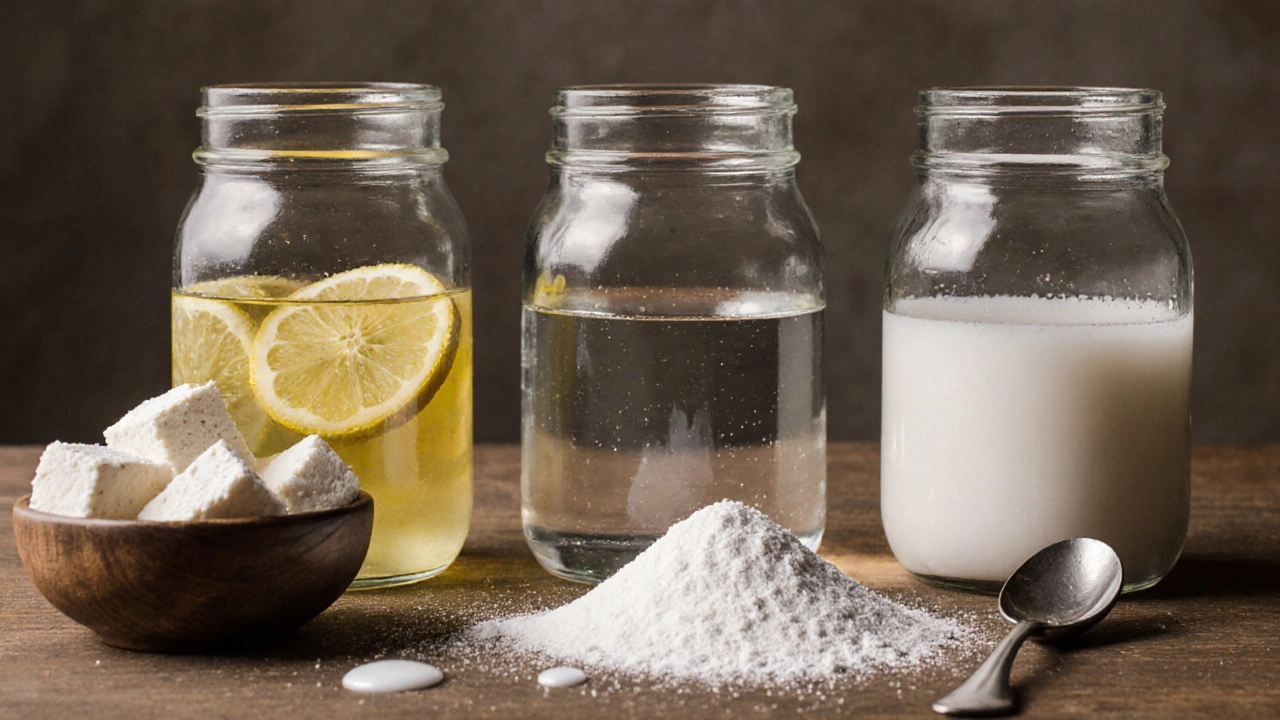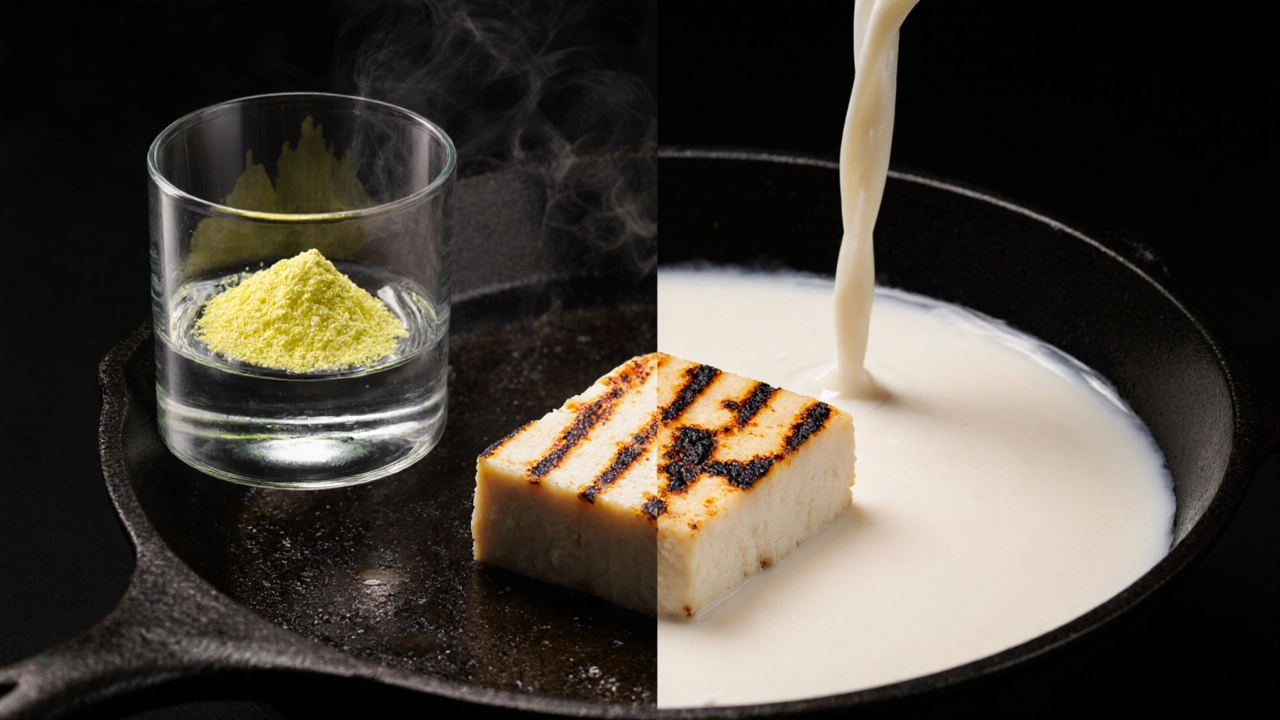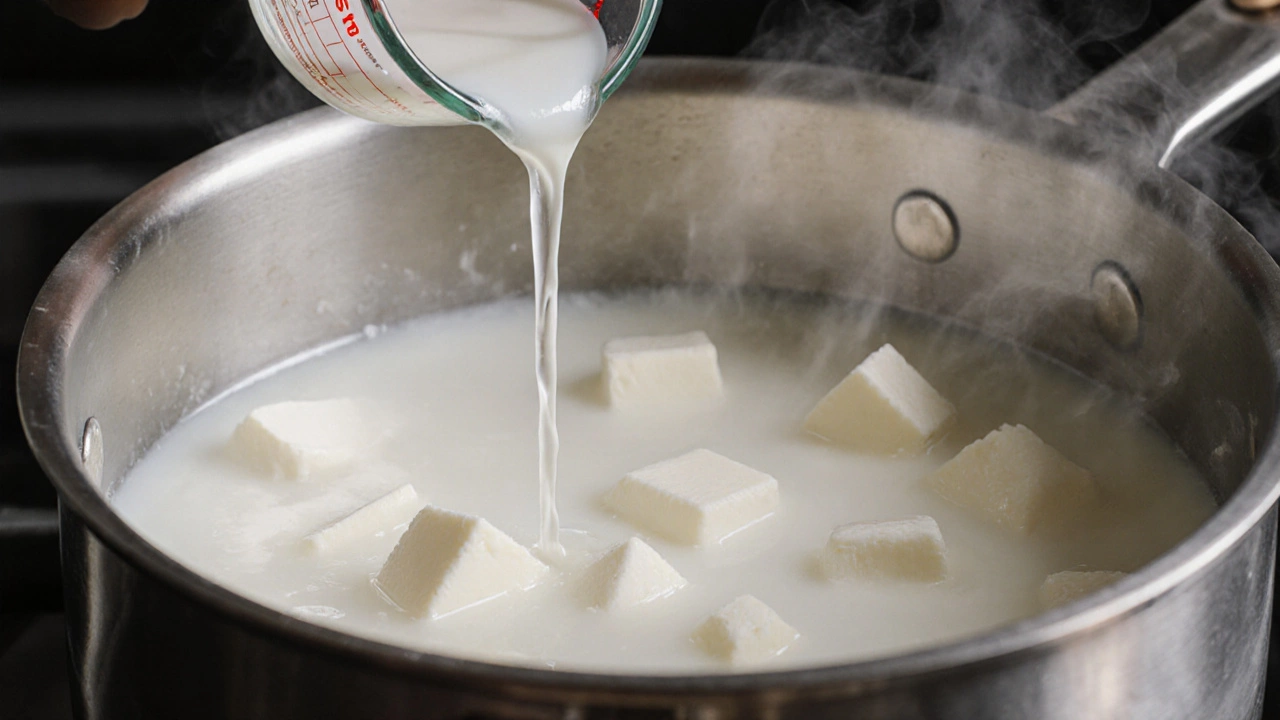Paneer Acid Calculator
Make Perfect Paneer
Pro Tip
Use full-fat milk for best results. Heat milk to full boil before adding acid. Press paneer for at least 30 minutes.
Recommended Acid Amount
Amount will display here
Description will display here
Texture & Best Uses
Texture information will appear here
When you make paneer at home, the acid you use changes everything. Not just the texture, but the flavor, the yield, even how well it holds up in your curry. You’ve probably tried lemon juice because it’s in every kitchen. But is it really the best? Maybe not. Let’s cut through the noise and find out what actually works best for soft, firm, creamy paneer that doesn’t fall apart in your palak paneer.
Why the acid matters more than you think
Paneer isn’t cheese you buy. It’s milk turned solid by acid. That’s it. No rennet, no cultures, no fancy equipment. Just milk and something sour. But not all acids are equal. Lemon juice, vinegar, yogurt, citric acid - they all work, but they do it differently. The acid breaks down the milk proteins (casein), forcing them to clump together and separate from the whey. How fast, how gently, and how clean that happens determines your final paneer.
Use too little acid? You get weak curds that crumble. Too much? The paneer tastes sour and gets rubbery. Wrong acid? You end up with a grainy texture or a weird aftertaste. It’s not magic. It’s chemistry. And knowing which acid gives you the cleanest curd is the difference between good paneer and great paneer.
Lemon juice: the common choice, but not the best
Lemon juice is what most home cooks reach for. It’s natural, easy, and smells fresh. But here’s the catch: lemon juice is weak. It’s about 5-6% citric acid. That means you need a lot of it - often half a cup or more for a liter of milk. And that extra liquid? It doesn’t just disappear. It gets trapped in the curds, making your paneer wetter, softer, and less firm.
Plus, lemon juice has pulp and oils. Those don’t dissolve. They float in the whey and can stick to the curds. You end up with tiny bits of pulp in your paneer. It’s not dangerous, but it’s distracting. If you’re making paneer for a dish where texture matters - like paneer tikka or stuffed paneer - that grittiness ruins the bite.
White vinegar: the quiet winner
White distilled vinegar - the kind you use for pickling - is the most reliable acid for paneer. It’s 5% acetic acid, clean, odorless after cooking, and strong enough to curdle milk quickly without needing too much. For one liter of full-fat milk, you only need 2-3 tablespoons. That’s less than half what you’d use with lemon juice.
The curds form fast and tight. The whey clears up almost immediately. No pulp. No lingering sour taste. And because you’re using less liquid, the paneer drains better and holds its shape when grilled or fried. I’ve made paneer with vinegar for over a decade. Every time, it’s firmer, whiter, and more consistent than with lemon.
Some people worry vinegar will leave a smell. It won’t. The heat from boiling and the rinsing with cold water remove any trace. What’s left is pure, milky paneer with no off-notes.

Citric acid powder: the professional’s secret
If you’ve ever bought paneer from an Indian grocery store, chances are it was made with citric acid powder. It’s the standard in commercial kitchens because it’s precise, cheap, and produces flawless results every time.
One teaspoon of citric acid powder (about 4 grams) is enough for a liter of milk. You dissolve it in a quarter cup of water, then stir it into hot milk. The curds snap into place within seconds. The whey is crystal clear. The paneer is dense, smooth, and holds up under high heat.
It’s the only acid that gives you total control. No guesswork. No variation. You can make paneer in under 10 minutes with zero waste. And because it’s pure citric acid - not juice or vinegar - there’s no flavor interference. Your paneer tastes like milk. That’s exactly what you want.
You can buy citric acid powder online or at baking supply stores. It’s cheaper than lemon juice per use. And it lasts for years in a sealed jar.
Yogurt or buttermilk: slow, but subtle
Some traditional recipes use yogurt or buttermilk. They work, but they’re slow. You need to simmer the milk for 20-30 minutes, stirring constantly, waiting for the curds to slowly separate. The result? A softer, more delicate paneer with a slight tang.
This method is great if you’re making paneer for desserts like rasgulla or for dishes where you want a meltier texture. But for frying, grilling, or stuffing - skip it. The curds are too fragile. And the flavor? It’s pleasant, but not neutral. You’ll taste the yogurt, which can clash with spices.
Comparison: Which acid wins?
| Acid | Amount per 1L milk | Curd speed | Texture | Flavor impact | Best for |
|---|---|---|---|---|---|
| Lemon juice | ½ cup (120 ml) | Medium | Soft, slightly grainy | Noticeable citrus | Quick snacks, salads |
| White vinegar | 2-3 tbsp (30-45 ml) | Fast | Firm, smooth | None after rinsing | Paneer tikka, frying, stuffing |
| Citric acid powder | 1 tsp (4 g) | Instant | Dense, professional | None | Every use, especially high-heat cooking |
| Yogurt/buttermilk | ¼ cup (60 ml) | Slow (20+ min) | Delicate, moist | Mild tang | Rasgulla, desserts |

Pro tips for perfect paneer every time
- Use full-fat milk. Low-fat or skim milk won’t curdle properly. You need the fat to bind the curds.
- Heat the milk to a full boil. Let it bubble for 2 minutes before adding acid. Cold or lukewarm milk won’t react.
- Add acid slowly. Pour it in while stirring gently. Don’t dump it all at once. You can always add more, but you can’t take it out.
- Let the curds sit for 5-10 minutes after adding acid. This lets them fully separate.
- Rinse the curds with cold water. This stops the cooking and removes any leftover acid taste.
- Press the paneer for at least 30 minutes. Use a heavy plate or a pot full of water. Don’t skip this. It’s what gives paneer its structure.
What not to use
Stay away from apple cider vinegar, balsamic vinegar, or lime juice. They’re too strong, too flavorful, or too inconsistent. Apple cider vinegar leaves a yeasty aftertaste. Balsamic stains the paneer dark brown. Lime juice has the same pulp issue as lemon, plus a sharper bite.
Don’t use sour cream or buttermilk from the fridge unless you’re making dessert paneer. They’re too diluted and unpredictable.
Final verdict: what to use
If you want the best paneer - firm, clean, neutral, and reliable - use citric acid powder. It’s the only acid that gives you restaurant-quality results every time, with zero guesswork.
If you don’t have citric acid, reach for white vinegar. It’s the next best thing. No weird flavors. No pulp. Just solid, versatile paneer that works in every dish.
Lemon juice? Fine for emergencies. But if you make paneer even once a month, invest in citric acid. A small jar costs less than £2 and lasts a year. You’ll wonder why you ever used anything else.
Can I use lemon juice to make paneer?
Yes, you can use lemon juice, but it’s not ideal. You need more of it, which makes the paneer wetter and softer. It can also leave a citrusy taste and small pulp bits in the curds. Use it only if you don’t have vinegar or citric acid.
Why is my paneer crumbly?
Crumbly paneer usually means you didn’t press it long enough, used low-fat milk, or added too much acid. Make sure you press it under weight for at least 30 minutes, use full-fat milk, and add acid slowly until the whey clears.
Where can I buy citric acid powder?
Look for citric acid powder in baking supply stores, online retailers like Amazon, or Indian grocery shops. It’s often sold as a preservative or for making cheese. It’s cheap and lasts for years.
Can I reuse the whey?
Yes. Whey is rich in protein and can be used in bread dough, smoothies, soups, or to cook rice. It adds nutrition and a subtle creaminess. Don’t throw it out.
Does paneer need to be refrigerated?
Yes. Store paneer in water in the fridge and change the water daily. It lasts 3-4 days. If you plan to use it later, freeze it - it thaws well and still holds its shape.
